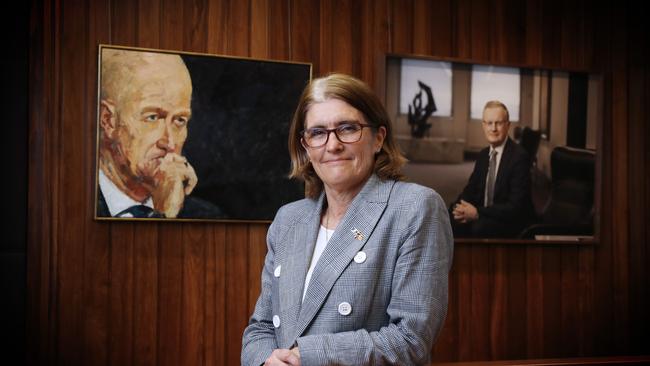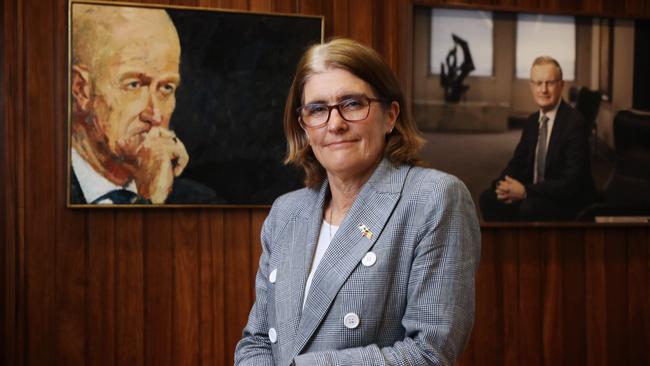RBA dials up warning on interest rates amid inflation concerns
The RBA ‘increased hawkishness’ could be due to mounting concern about the inflation outlook or a just a change in style under the new boss Michele Bullock.

Business
Don't miss out on the headlines from Business. Followed categories will be added to My News.
The Reserve Bank has increased its interest rate warning amid stubbornly-high services-sector inflation and recent increases in the prices of fuel, houses and rents.
While repeating that “some further tightening of policy may be required should inflation prove more persistent than expected”, the minutes of the RBA’s October Board meeting also said the Board “has a low tolerance for a slower return of inflation to target than currently expected.”
The RBA Board’s “low tolerance” on inflation – currently not forecast to return to the 2-3 per cent target band until late 2025 - suggests Australia’s central bank will lift rates at its November Board meeting if quarterly CPI data next week show a higher-than-expected rise in inflation.
The minutes capped a rebound in Australia’s S&P/ASX 200 share index at 6100 points.
The Australian dollar rose as much as 0.4 per cent to a three-day high of US63.67c as the 3-year bond yield jumped to a two-week high of 4.1 per cent, in line with the current level of the cash rate.
How much of this “increased hawkishness” stems from increased concern about the inflation outlook or a change in style under the new RBA Governor, Michele Bullock, is unclear.
Ms Bullock may provide further colour on her thinking when she speaks at the AFSA Annual Summit Panel at 0930am AEDT on Wednesday.
“In our view, higher services inflation in August was likely the catalyst for the new hawkish addition around low tolerance,” said Citi senior economist Faraz Syed.
But the minutes also said: “whether or not a further increase in interest rates is required would, therefore depend on the incoming data and how these alter the economic outlook and the evolving assessment of risks”. In other words, while the RBA has a low tolerance to sticky inflation, it will only lift interest rates again if the data lead it to predict an even slower return to its 2-3 per cent target.

“The wording changes this month imply that the Board is willing to raise rates again if there is a material upside surprise to the medium-term inflation outlook,” said Westpac chief economist, Luci Ellis. “But if things keep on turning out broadly in line with the sequence of staff forecasts over this year, the Board is content to hold rates steady.”
According to Dr Ellis, who previously worked as the Assistant Governor (Economic) at the RBA from December 2016 until October 2023, further rate increases by the Bank aren’t “completely off the table”, but are only likely if the inflation outlook changes materially from here.
She said the RBA Board’s “low tolerance” for a slower return of inflation to its target was “particularly noteworthy” as it “signals their willingness to act if the outlook changes.”
However, the subsequent statement about “whether or not a further increase in interest rates is required” was “also significant”, as it “reads as a deliberate pointer to the Board’s assessment that it would only need to tighten further in the event of an upside surprise.”
She said the Board’s increased willingness to spell out that no surprises means no further moves probably stems from some of the shifts in their assessment of the data and risks from prior months.
In that regard, some of the points that stood out to Dr Ellis in the Minutes included the Board’s observations that inflation had “abated from its peak” and the labour market had reached a “turning point as labour supply had picked up and labour demand had moderated.”
While noting that the unemployment rate remained at 3.7 per cent in August, slightly above the 50-year low of 3.5 per cent, the Minutes also pointed out that underemployment had risen a little more noticeably, as had the youth and medium-term unemployment rates.
“It was noted that these measures of spare capacity tend to be more responsive to economic activity than the aggregate unemployment rate,” the Minutes said. “Members also discussed hours-based measures of spare capacity in the labour market, as hours worked by current employees are often a key margin of adjustment as conditions in the labour market soften.”
“Hours-based unemployment and underemployment rates had both ticked up in recent months from their lows reached in late 2022. Business surveys and information from firms in the Bank’s liaison program had showed an improvement in labour availability. Voluntary turnover rates had also declined, though finding suitable workers continued to be difficult.
“Similarly, job vacancies had fallen from their peak in 2022 but remained high.”
In other words, the Board is more confident that the labour market will loosen, easing the recent upward pressure on wages stemming from increases granted by the Fair Work Commission.

Thursday’s labour force data for September are expected to show that the unemployment rate was unchanged at 3.7 per cent and that employment rose by 18,000 based on the ABS survey.
Dr Ellis said the discussion on wages in the RBA minutes “also seemed a lot more sanguine than earlier in the year, despite worries about productivity.”
“Against these more sanguine comments, it is notable that the Board did discuss the potential upside risks coming from the recovery in the established housing market and the lower exchange rate,” she said.
“However, the Board seems to have concluded that these did not warrant a response at this time.”
On the housing market, she said the continued recovery in prices does mean that the wealth effects on household consumption could be stronger than previously expected, but that this must be set against the overall weak picture for spending.
“The squeeze on household incomes from inflation, a rising tax take and higher interest rates is the more important driver of consumption outcomes,” Dr Ellis said.
“The outlook for household spending remains weak in the face of these headwinds.”
Originally published as RBA dials up warning on interest rates amid inflation concerns



